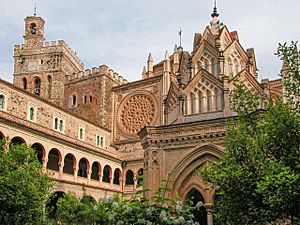Alfonso Enríquez facts for kids
Quick facts for kids Alfonso Enríquez |
|
|---|---|
| Lord of Medina de Rioseco Admiral of Castile |
|
 |
|
| Arms of Alfonso Enríquez | |
| Spouse(s) | Juana de Mendoza |
| Issue | |
| Fadrique Enríquez | |
| Noble family | House of Enríquez |
| Father | Fadrique Alfonso |
| Born | 1354 Guadalcanal |
| Died | 1429 Guadalupe |
| Burial | Monastery of Santa Clara, Palencia |
Alfonso Enríquez (born in Guadalcanal in 1354, died in Guadalupe in 1429) was an important figure in Spanish history. He was known as the Lord of Medina de Rioseco and held the powerful title of Admiral of Castile. This meant he was in charge of the navy for the Kingdom of Castile.
Contents
Who Was Alfonso Enríquez?
Alfonso Enríquez was the son of Fadrique Alfonso. His father was a leader of the Order of Santiago, a famous knightly order. Sadly, his father was killed in 1358.
Alfonso was the first in his family to become the Admiral of Castile, starting in 1405. He also became the first Lord of Medina de Rioseco. His grandparents were King Alfonso XI of Castile and Eleanor de Guzmán. This made him a nephew of King Henry II of Castile and a cousin of King John I of Castile. He had a brother, Pedro Enriquez, who was a count and a Constable of Castile. His sister, Eleanor, married a Marshal of Castile.
Life and Achievements
Alfonso Enríquez had to stay hidden for a while after his father's death. This was because his uncle, King Pedro I, had ordered his father's killing. Some historical writings suggest that Alfonso's mother, Paloma, was of Jewish background. One story even tells of King Ferdinand the Catholic joking about this family connection.
Expanding His Territory
In 1389, King John I of Castile gave Alfonso land around Aguilar de Campos. Over the years, Alfonso worked to make his territory even bigger. He served the King as a commander and managed the castle of Medina de Rioseco until 1402.
Marriage and Family Life
In 1387, Alfonso married Juana de Mendoza. Together, they helped rebuild the Monastery of Santa Clara de Palencia. This monastery was meant to be the burial place for the Admirals of Castile and their families.
It is believed that Juana de Mendoza played a role in Alfonso becoming Admiral of Castile. The title passed to him in 1405 after her brother, Diego Hurtado de Mendoza, who held the post, died. The Enríquez family kept the title of Admiral of Castile for 300 years, from 1405 to 1705. Alfonso was the most famous admiral in his family, winning many important sea battles.

In 1407, Alfonso led his fleet to victory against the combined navies of Tunis, Granada, and Tlemcen. This was his last major sea battle. After this, he focused on inspecting the fleet and leading land battles, like capturing Antequera in 1410. He was also involved in the King's court and its events.
In 1421, King John II of Castile officially granted him the lordship of Medina de Rioseco. The King did this because of Alfonso's "many good and loyal services." Because of Alfonso, the city is still known as the City of the Admirals.
Towards the end of his life, Alfonso retired to the monastery of Santa María de Guadalupe. He died there in 1429 at the age of 75. He was buried with his wife and some of his children in the Santa Clara de Palencia monastery, which they had helped to found. In his will, he left money for building chapels at the monastery.
Historians described Alfonso as a medium-sized man, a bit chubby, with red hair. He was known for being quiet but could also get irritated quickly.
Alfonso's Children
Alfonso and Juana had many children. Here are some of them:
- Fadrique Enriquez (born around 1388) was their first son. He married Mariana Fernandez de Cordoba and Ayala. Their daughter, Juana of Aragon, became a queen.
- Enrique Enríquez de Mendoza started new family lines. He became the Count of Alba de Liste.
- Beatriz Enríquez married Pedro de Portocarrero.
- Leonor Enríquez married Rodrigo Pimentel, the Count of Benavente.
- Isabel Enriquez married Juan Ramirez de Arellano.
- Maria Enriquez married Juan de Rojas.
- Mencia Enriquez married Juan Fernandez Manrique de Lara, who became a count.
- Rodrigo Enriquez became an Archdeacon.
Alfonso also had one son outside of marriage, named Juan Enríquez. His father trusted him to be a captain general of the fleet.
Legend of the Christ of the Clear
There is a special story about a statue of Christ in the Church of Santa Clara de Palencia. It is called the Cristo de las Claras. The legend says that during one of Alfonso's sea battles against the Moors (between 1407 and 1410), his sailors saw something glowing in the water. When they got closer, they found a glass case with a statue of Christ lying inside.
Alfonso was amazed by this discovery. He decided to move the statue to Palenzuela. But as it was being carried on an animal's back, the animal stopped stubbornly in front of a castle where Poor Clares nuns lived. When they let the animal go, it went straight to the nuns' monastery. People believed this was a sign from God, so they left the statue there for everyone to see and honor.
See also
 In Spanish: Alfonso Enríquez (almirante de Castilla) para niños
In Spanish: Alfonso Enríquez (almirante de Castilla) para niños

